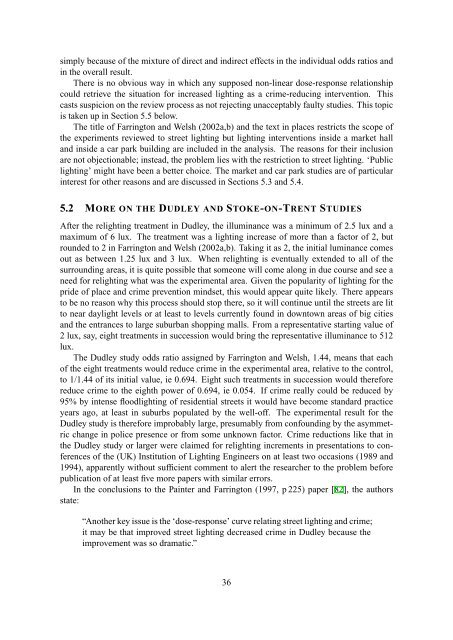outdoor lighting and crime, part 1 - Astronomical Society of Victoria
outdoor lighting and crime, part 1 - Astronomical Society of Victoria
outdoor lighting and crime, part 1 - Astronomical Society of Victoria
You also want an ePaper? Increase the reach of your titles
YUMPU automatically turns print PDFs into web optimized ePapers that Google loves.
simply because <strong>of</strong> the mixture <strong>of</strong> direct <strong>and</strong> indirect effects in the individual odds ratios <strong>and</strong><br />
in the overall result.<br />
There is no obvious way in which any supposed non-linear dose-response relationship<br />
could retrieve the situation for increased <strong>lighting</strong> as a <strong>crime</strong>-reducing intervention. This<br />
casts suspicion on the review process as not rejecting unacceptably faulty studies. This topic<br />
is taken up in Section 5.5 below.<br />
The title <strong>of</strong> Farrington <strong>and</strong> Welsh (2002a,b) <strong>and</strong> the text in places restricts the scope <strong>of</strong><br />
the experiments reviewed to street <strong>lighting</strong> but <strong>lighting</strong> interventions inside a market hall<br />
<strong>and</strong> inside a car park building are included in the analysis. The reasons for their inclusion<br />
are not objectionable; instead, the problem lies with the restriction to street <strong>lighting</strong>. ‘Public<br />
<strong>lighting</strong>’ might have been a better choice. The market <strong>and</strong> car park studies are <strong>of</strong> <strong>part</strong>icular<br />
interest for other reasons <strong>and</strong> are discussed in Sections 5.3 <strong>and</strong> 5.4.<br />
5.2 MORE ON THE DUDLEY AND STOKE-ON-TRENT STUDIES<br />
After the re<strong>lighting</strong> treatment in Dudley, the illuminance was a minimum <strong>of</strong> 2.5 lux <strong>and</strong> a<br />
maximum <strong>of</strong> 6 lux. The treatment was a <strong>lighting</strong> increase <strong>of</strong> more than a factor <strong>of</strong> 2, but<br />
rounded to 2 in Farrington <strong>and</strong> Welsh (2002a,b). Taking it as 2, the initial luminance comes<br />
out as between 1.25 lux <strong>and</strong> 3 lux. When re<strong>lighting</strong> is eventually extended to all <strong>of</strong> the<br />
surrounding areas, it is quite possible that someone will come along in due course <strong>and</strong> see a<br />
need for re<strong>lighting</strong> what was the experimental area. Given the popularity <strong>of</strong> <strong>lighting</strong> for the<br />
pride <strong>of</strong> place <strong>and</strong> <strong>crime</strong> prevention mindset, this would appear quite likely. There appears<br />
to be no reason why this process should stop there, so it will continue until the streets are lit<br />
to near daylight levels or at least to levels currently found in downtown areas <strong>of</strong> big cities<br />
<strong>and</strong> the entrances to large suburban shopping malls. From a representative starting value <strong>of</strong><br />
2 lux, say, eight treatments in succession would bring the representative illuminance to 512<br />
lux.<br />
The Dudley study odds ratio assigned by Farrington <strong>and</strong> Welsh, 1.44, means that each<br />
<strong>of</strong> the eight treatments would reduce <strong>crime</strong> in the experimental area, relative to the control,<br />
to 1/1.44 <strong>of</strong> its initial value, ie 0.694. Eight such treatments in succession would therefore<br />
reduce <strong>crime</strong> to the eighth power <strong>of</strong> 0.694, ie 0.054. If <strong>crime</strong> really could be reduced by<br />
95% by intense flood<strong>lighting</strong> <strong>of</strong> residential streets it would have become st<strong>and</strong>ard practice<br />
years ago, at least in suburbs populated by the well-<strong>of</strong>f. The experimental result for the<br />
Dudley study is therefore improbably large, presumably from confounding by the asymmetric<br />
change in police presence or from some unknown factor. Crime reductions like that in<br />
the Dudley study or larger were claimed for re<strong>lighting</strong> increments in presentations to conferences<br />
<strong>of</strong> the (UK) Institution <strong>of</strong> Lighting Engineers on at least two occasions (1989 <strong>and</strong><br />
1994), apparently without sufficient comment to alert the researcher to the problem before<br />
publication <strong>of</strong> at least five more papers with similar errors.<br />
In the conclusions to the Painter <strong>and</strong> Farrington (1997, p 225) paper [82], the authors<br />
state:<br />
“Another key issue is the ‘dose-response’ curve relating street <strong>lighting</strong> <strong>and</strong> <strong>crime</strong>;<br />
it may be that improved street <strong>lighting</strong> decreased <strong>crime</strong> in Dudley because the<br />
improvement was so dramatic.”<br />
36
















